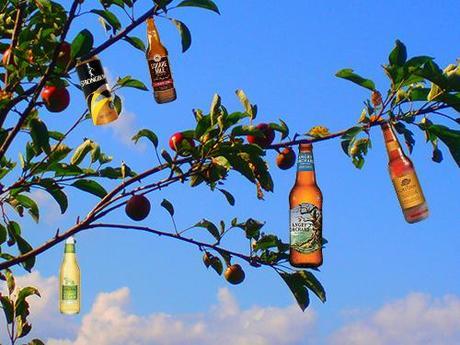
Anyone hear the clinking of glasses coming from Boston a couple weeks ago? It wasn’t because the Red Sox are having a good season.
It’s because Boston Beer – the company that produces the Sam Adams brand of beer – is having a hell of a year financially. But it’s not just because of the new Sam Can.
Boston Beer announced their second quarter earnings Aug. 1 and they were good. The company showed a net revenue of $181.3 million, an increase of 23 percent from the same year-ago period and enough to get “Boston Beer” splashed across all sorts of headlines deeming the company’s stock as a top-notch investment.
But how did Boston Beer perform so well? Was it the Sam Can? Was it the release of fan-favorite Summer Ale? Was it a renewed interest in Boston Lager?
I’d argue it could have nothing to do with beer at all.
It turns out, it may have a lot to do with cider – and Boston Beer isn’t alone.
Boston Beer’s Angry Orchard cider rolled out nationally last year, but was originally seen as merely a niche product. In the past year, though, things changed. Angry Orchard now makes up about 38 percent of total U.S. cider sales. Even if Boston Lager can’t stay on the shelves, there’s no denying Angry Orchard is doing a good job of holding Boston Beer up at record stock prices, especially when Angry Orchard is estimated to make up 20 percent of Boston Beer’s total volume by the end of 2015.
Of course, Boston beer isn’t the only company riding this wave.
As the cider market continues to grow – sales as a percentage of beer are nearing 1 percent and the market is growing 9 to 10 percent globally – everyone else wants to hop on this train. The list of producers reads more like a walking wounded of beer production:
- AB InBev sells Stella Artois Cidre and Michelob Ultra Light Cider
- Heineken distributes Strongbow
- SABMiller and Molson Coors own Crispin
What do these three companies have in common? Beer sales are down and they need to pick-up sales elsewhere. The Craft Brew Alliance, partially owned by AB InBev and producers of brands like Red Hook and Widmer Brothers, recently launched Square Mile Cider among declining sales, too.
(It’s worth noting that even as beer sales are down for these companies, profits are typically up thanks to what the Brewers Association would call “crafty” tactics with “premium” beers.)
The idea is that if “traditional” avenues of beer aren’t working as well, it’s time to diversify the portfolio. After all, analysts point out that cider attracts more female customers than beer and commands a higher price than craft beer. Even during a time with declining beer sales, it’s an easy way to buoy profits. U.S. sales of Stella Artois Cidre come after A-B InBev saw volume decline 5 percent in the U.S. in its first quarter.
But that’s not all, as Big Beer is getting sneaky about how they can push consumers toward their growing cider market, which tripled from 2007 to 2012. How? Slowly inch drinkers from cheaper beer-like alternatives to more expensive cider options. Perhaps this is why AB InBev now has Shock Top Honeycrisp Apple Wheat and SABMiller has Redd’s Apple Ale. These relatively inexpensive gateway brews can lead to the more expensive cider that more people are enjoying, no matter their gender.
Both Angry Orchard (1) and Redd’s Apple Ale (4) have been among the top-5 largest gains in on-premise “beer” distribution in 2013, showing that when people are out having a good time, it’s becoming more common for them to seek something sweet like cider over a bitter IPA or malty brown ale.
How ’bout them apples?
What do you think? What does the future hold for cider in relation to beer?
+Bryan Roth
“Don’t drink to get drunk. Drink to enjoy life.” — Jack Kerouac

